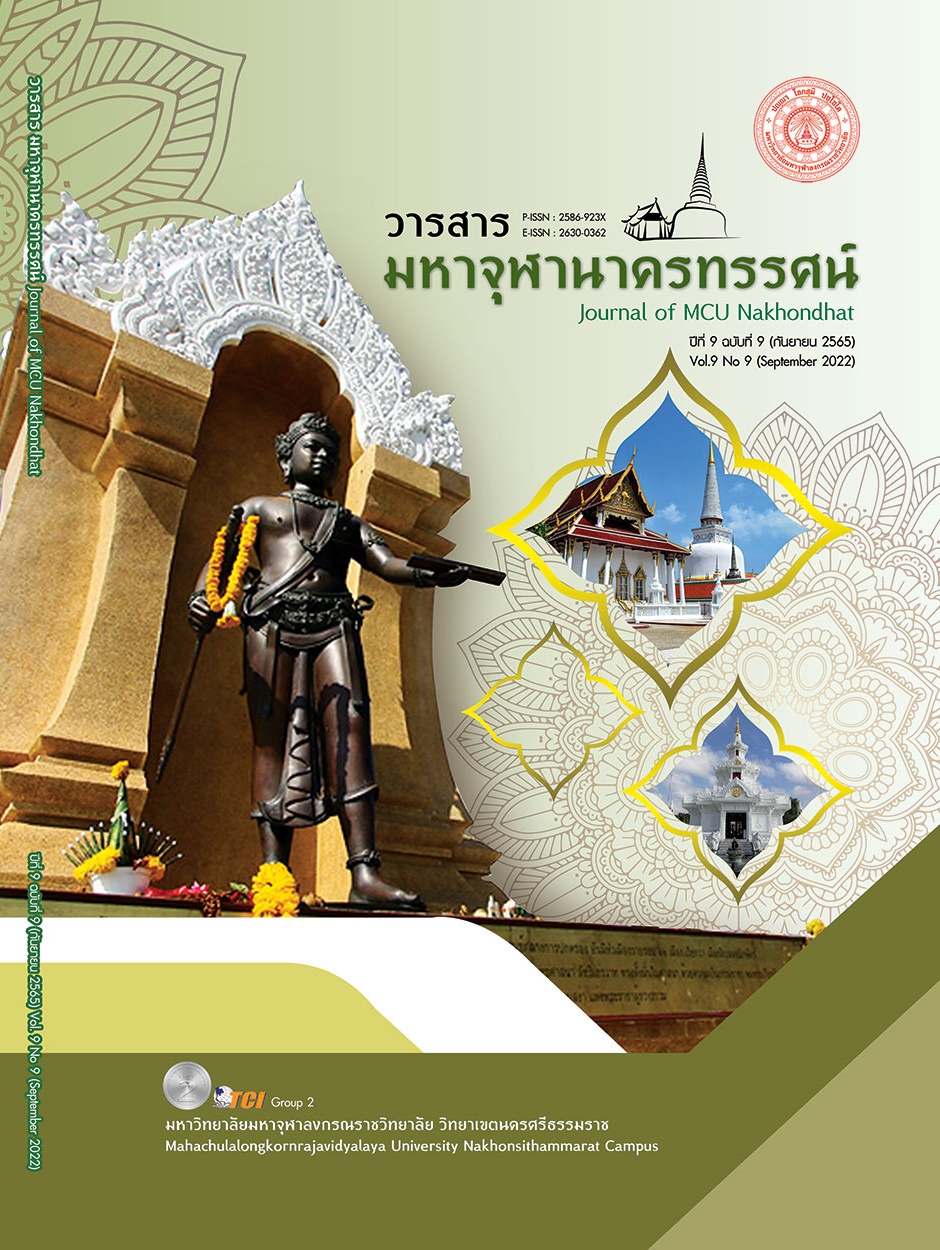MANAGEMENT OF THE INNOVATION OF COMMUNITIES IN THAI SOCIETY
Main Article Content
Abstract
The objectives of this research article were to: 1) study way of life of role-model communities in Thai society that complied with the principle of 5 Buddhist precepts, 2) analyze creative innovation of role-model communities that complied with the 5 Buddhist precepts villages and 3) to study management model on innovation of role-model villages that complied with the principle of 5 Buddhist precepts in Thailand. This qualitative was conducted by studying of documents and in-depth interview. Sample selected by purposive sampling was 25 informants consisted of 5 groups each group 5 people as: 1) Monks in provincial level, 2) Monks in district level, 3) Monks who were complied with the principle of 5 Buddhist precepts) , 4) Laymen in provincial level and 5) Laymen in district level. Contents were analyzed and concluded in form of overview. The research revealed that: 1) Way of life of role-model communities in Thai society that complied with the principle of 5 Buddhist precepts and applied with their daily life by using monks as a main mechanism for being the center of activities, inviting government agencies to support internal activities in their villages both of Sangha and agency’s activities. People in the 5 Buddhist precepts villages had good cooperation with monks government agencies; 2) Analyzing creative innovation of role-model communities that complied with the 5Buddhist precepts villages and cohabitation of communities in Thai society found that in overall it was a behavior of cohabitation for a long time under the framework of the 5 Buddhist precepts villages project that each community in the village agreed to fortify their cooperations and it became a culture of cohabitation of each community for conserving and handing over to the next generation well as creating processes to continually promote until now; 3) Creating of a standard criteria for living in accordance with the 5 Buddhist precepts to support the management model on innovation of villages that complied with the principle of 5 Buddhist precepts that had 3 targets for: 1) Happiness for their own, 2) Happiness for society and 3) Sustainable economy and self-reliance.
Article Details

This work is licensed under a Creative Commons Attribution-NonCommercial-NoDerivatives 4.0 International License.
References
พระครูสุพัฒนกาญจนกิจ. (2561). การพัฒนารูปแบบการทำงานของคณะสงฆ์จังหวัดกาญจนบุรี ในโครงการหมู่บ้านรักษาศีล 5. วารสารสันติศึกษาปริทรรศน์ มจร, 6(2), 41-55.
พระมหาบุญเลิศ อินฺทปฺญโญ และคณะ. (2559). หมู่บ้านรักษาศีล 5 : รูปแบบและกระบวนการเสริมสร้างวัฒนธรรม การอยู่ร่วมกันของสังคมไทย. ใน รายงานการวิจัย. สถาบันวิจัยพุทธศาสตร์ : มหาวิทยาลัยมหาจุฬาลงกรณราชวิทยาลัย.
พระมหาสุทิตย์ อาภากโร. (2558). ศีล 5 คุณค่าของชีวิตและสังคม. พระนครศรีอยุธยา: สถาบันวิจัยพุทธศาสตร์ มหาวิทยาลัยมหาจุฬาลงกรณราชวิทยาลัย.
พระเมธีวราภรณ์. (2552). เบญจศีล เบญจธรรม : อุดมชีวิตของมนุษย์. พิมพ์ครั้งที่ 2. กรุงเทพมหานคร : สำนักพิมพ์ต้นบุญ.
พระราชสีมาภรณ์. (2546). พระพุทธศาสนากับวัฒนธรรมไทย. กรุงเทพมหานคร: มหาจุฬาลงกรณราชวิทยาลัย.
พุทธทาสภิกขุ. (2539). ทาน ศีล ภาวนา. กรุงเทพมหานคร: สุขภาพใจ.
พูลศักดิ์ หอมสมบัติ และคณะ. (2559). ครอบครัวรักษาศีล 5 : รูปแบบและการเสริมสร้างวัฒนธรรมการดำเนินชีวิตของครอบครัวในจังหวัดอุบลราชธานี. ใน รายงานการวิจัย. สถาบันวิจัยพุทธศาสตร์ : มหาวิทยาลัยมหาจุฬาลงกรณราชวิทยาลัย.
สานุ มหัทธนาดุล และคณะ. (2558). ศีลห้า : เกณฑ์ชี้วัดและการเสริมสร้างสันติสุขของบุคคลและสังคม . ใน รายงานการวิจัย. สถาบันวิจัยพุทธศาสตร์ : มหาวิทยาลัยมหาจุฬาลงกรณราชวิทยาลัย.
สำนักงานพระพุทธศาสนาจังหวัดสระบุรี. (2560). โครงการหมู่บ้านรักษาศีล 5. เรียกใช้เมื่อ 2 มีนาคม 2564 จาก http://sri.onab.go.th
สำลี รักสุทธี. (2543). ศีล สุดยอดวินัยของศาสนาพุทธ. กรุงเทพมหานคร: พัฒนาศึกษา.
สุมาลี มหณรงค์ชัย. (2558). ศีล 5 ฉบับคู่มือรักษาใจ “ศีลปาโล”. กรุงเทพมหานคร : อมรินทร์.


